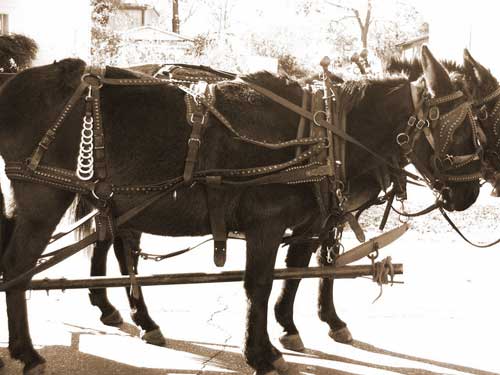 by Preston MacDougall April 11, 2007
Mules, as you may know, are a hybrid species created by crossing a jack with a mare. Farmer Brown has 23 pairs of chromosomes, Sire Jack has 31, Dam Mare has 32, but, like all mules, Idaho Gem has 31 and a half pairs.  Credit: morguefile.com
After that, attempts to clone horses were off to the races, especially in Europe where geldings commonly enter the winner's circle after top-level equine competitions. People have been known to bet on mules as well, and a fast one named Taz had an owner, Don Jacklin, that was eager to keep the winning streak going. Jacklin took interest in the research being led by Dr. Gordon Woods, Professor of Animal and Veterinary Science at the University of Idaho. Professor Woods and his team sought to clear the technical hurdles of equine cloning, some of which are related to lower concentrations of calcium ions in cells and an associated slower rate of cell activity than is observed in many other mammals, including humans. Woods' interest in calcium extended beyond the finish line in the equine cloning race. He had already noted that, in addition to low calcium ion concentrations, horses have a zero handicap when it comes to fatal cases of prostrate cancer. In men, however, of all metastatic cancers, 13 to 14 percent are of the prostate. Woods wondered if understanding the chemical roles of calcium ions in cell activity, and reproduction in particular, might not lead to breakthroughs in treatment of prostate cancer. It was worth a bet. In Idaho, the best bet in the horse family was on mules related to Taz. So Woods and his team (a 20-mule scientist team and a Taz booster?) took a cell from the skin tissue of a blood-brother to Taz, removed its nucleus with all 63 chromosomes, and inserted it into an evacuated egg from a horse. A small pulse of electricity got the cell dividing, and it was eventually transferred to a surrogate mother. Many skin cells started this race, but only three finished it, as the worlds' first, second and third clones in the horse-family. First across the line was Idaho Gem, a jack born on May 4, 2003. His two identical brothers (not counting the cell donor), Utah Pioneer and Idaho Star, were born later, all by different surrogate mothers. By all accounts, the racing brothers are off to successful careers. Idaho Gem won two of his first six races, and placed in all but one. Mr. Jacklin should be happy as a clone. Unlike thoroughbred horses, Idaho Gem has a pedigree that sounds a bit like a storyline from Back to the Future - the Stable Sequel. You see, Taz's brother, who was Idaho Gem's "father" - in the way that the mammary cell-donating ewe was Dolly's mother - was never born. The skin cell, from which Idaho Gem was cloned, was taken from an aborted mule fetus. So, like Marty McFly, Idaho Gem became a hero before his father was born. But, as could only happen with clones, his father didn't have to born, just donate a cell. Confused? Don't worry, so are many members of Congress when it comes to legislation restricting federally-funded embryonic stem cell research. If clues to prostrate cancer are uncovered from equine reproduction research, then in order for medical science to finish the race and deliver a cure for this deadly disease, it is very likely that some experiments on embryonic stem cells, perhaps involving so-called therapeutic cloning, will be among the hurdles that need to be cleared during the course of research. Dr. Woods chose Moscow, where there happens to be fewer restrictions on stem cell research, as the lab location for a private cancer research company that he founded (CancEr2). Perhaps this decision was based on scientific reasons, instead of political ones, but I wouldn't bet on it.
On the Web:
Publish A Letter on SitNews Read Letters/Opinions Submit A Letter to the Editor
|